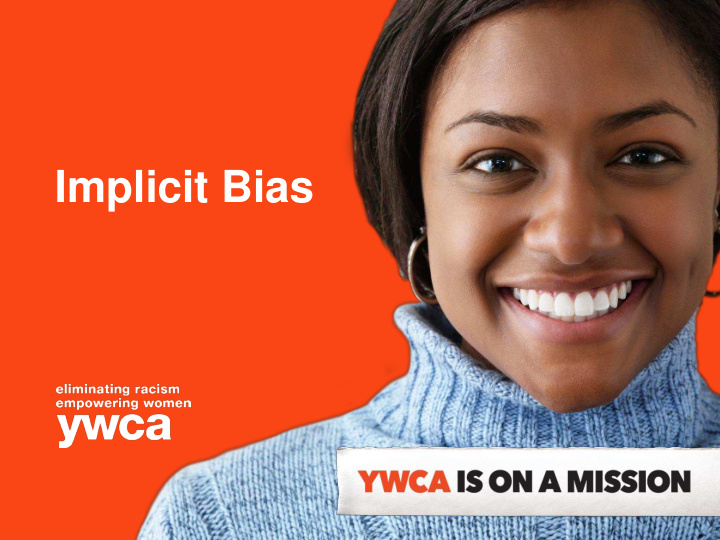



Implicit Bias
Implicit bias • Implicit bias refers to attitudes or stereotypes that affect our understanding, actions and decisions in an unconscious manner. • It's different from suppressed thoughts we might conceal to keep the peace; it's the opposite of explicit bias, which refers to attitudes or beliefs that we fully admit to. 2
Definition of terms • A stereotype is an exaggerated belief, image or distorted truth about a person or group — a generalization that allows for little or no individual differences or social variation. Stereotypes are based on images in mass media, or reputations passed on by parents, peers and other members of society. Stereotypes can be positive or negative. • A prejudice is an opinion, prejudgment or attitude about a group or its individual members. A prejudice can be positive, but in our usage refers to a negative attitude. Prejudices are often accompanied by ignorance, fear or hatred. Prejudices are formed by a complex psychological process that begins with attachment to a close circle of acquaintances or an "in-group" such as a family. Prejudice is often aimed at "out-groups." • Discrimination is behavior that treats people unequally because of their group memberships. Discriminatory behavior, ranging from slights to hate crimes, often begins with negative stereotypes and prejudices. 3
How do we learn prejudice? • Many studies have shown that as early as age 3, children pick up terms of racial prejudice without really understanding their significance. • Early in life, most children acquire a full set of biases that can be observed in verbal slurs, ethnic jokes and acts of discrimination. • Once learned, stereotypes and prejudices resist change, even when evidence fails to support them or points to the contrary. 4
Hidden bias • Scientific research has demonstrated that biases thought to be overcome remain as "mental residue" in most of us. • "Implicit Association Tests" (IATs) can tap hidden, or automatic, stereotypes and prejudices that aren’t in our conscious control. • Many test takers can "feel" their hidden prejudices as they perform the tests. 5
Bias and behavior • Unconscious beliefs and attitudes have been found to be associated with language and certain behaviors such as eye contact, blinking rates and smiles. • Studies have found, for example, that school teachers clearly telegraph prejudices, so much so that some researchers believe children of color and white children in the same classroom effectively receive different educations. • A classic experiment showed that white interviewers sat farther away from black applicants than from white applicants, made more speech errors and ended the interviews 25% quicker. Such discrimination has been shown to diminish the performance of anyone treated that way, whether black or white. 6
Unconscious bias isn’t just a racial thing… 7
LGBTQ bias 8
LGBTQ bias 9
Gender bias Dr. Brian Welle, Director of People Analytics, Google 10
Gender bias impact • We're encouraged to think of women as traditionally family-oriented and men as career-oriented. • Biases around family have a direct impact on people's lives. For example, 89% of men say that paid paternity leave after the birth of a child is really important for them, but only 20% of companies offer any kind of paid leave for new dads. 11
Gender bias impact Loaded language A study of performance reviews found that, compared with men, women receive: – 2.5 times as much feedback about having an aggressive communication style – 2.4 times as many references to team accomplishments – About half as many references to having vision – About half as many references to their technical expertise – One third as much feedback linked to a business outcome Source: Stanford University, Clayman Institute for Gender Research 12
Am I bias? 13
Let’s take a look… Ask yourself, who are your best friends? • Picture your three best friends. Chances are, they're the same race as you. A 2015 CNN/Kaiser Foundation poll found that despite the millennial reputation for inclusiveness, young white Americans don't have especially multicultural friend groups. • Younger whites are almost twice as likely as Hispanics and blacks to say they socialize mostly within their own race (68% of whites age 18-34 say they overwhelmingly associate with other whites, compared with 37% of Hispanics and 36% of blacks of the same age); the gap is just as wide on where young whites choose to live. 14
Let’s take a look… Do you choose to live in neighborhoods that look like you? • If you are looking to buy or rent in a certain neighborhood, is there a point at which you think "there are too many people unlike me in this community, and I'm looking elsewhere"? • According to the 2015 Kaiser poll, a majority of whites (69%) say the people they live around are mostly of the same race as them, while Hispanics predominantly say they live around people of other races (59%). Blacks are split, with 51% saying they live around people of other races and 41% saying they live around mostly other black people. 15
Commit to change If people are aware of their hidden biases, they can monitor and attempt to ameliorate hidden attitudes before they are expressed through behavior. This compensation can include attention to language, body language, and to the stigmatization felt by target groups. 16
Recommend
More recommend